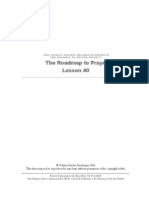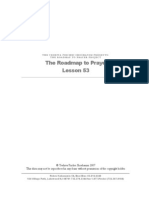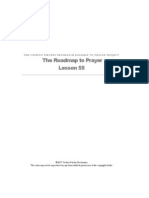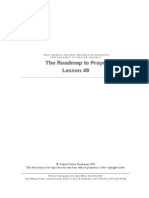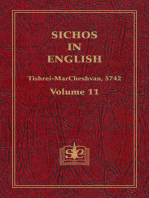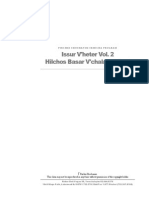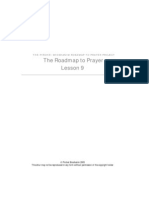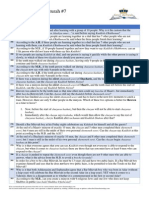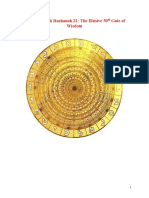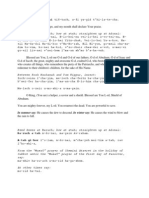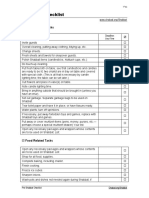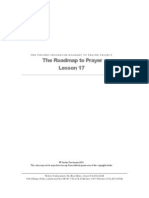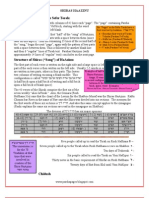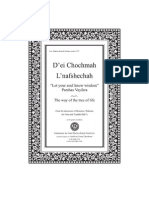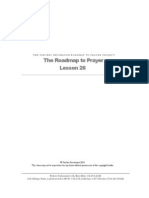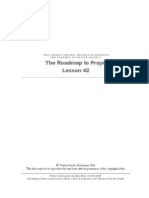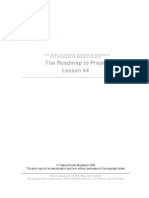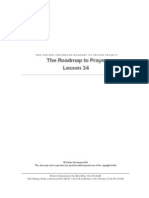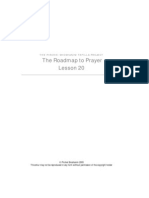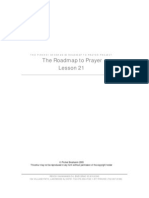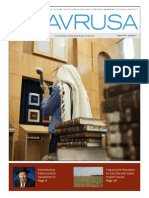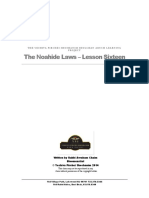Roadmap To Prayer Lesson 46
Roadmap To Prayer Lesson 46
Uploaded by
Krisztian KelemenCopyright:
Available Formats
Roadmap To Prayer Lesson 46
Roadmap To Prayer Lesson 46
Uploaded by
Krisztian KelemenOriginal Title
Copyright
Available Formats
Share this document
Did you find this document useful?
Is this content inappropriate?
Copyright:
Available Formats
Roadmap To Prayer Lesson 46
Roadmap To Prayer Lesson 46
Uploaded by
Krisztian KelemenCopyright:
Available Formats
T H E Y E S H I V A P I R C H E I S H O S H A N IM P R ES E N T S : THE ROADMAP TO PRAYER PROJECT
The Roadmap to Prayer Lesson 46
Yeshiva Pirchei Shoshanim 2006 This shiur may not be reproduced in any form without permission of the copyright holder
Rehov Kahanamin 54, Bnei Brac 03.616.6340 164 Village Path, Lakewood NJ 08701 732.370.3344 fax 1.877.Pirchei (732.367.8168)
The Ro admap to Prayer
46
Lesson
Maariv: Changes in Tefilla (prayer)
On Rosh Hashanah and Yom Kippur, each congregation sings the Tefillos (prayers) in a special tune and melody which is used exclusively for the Yamim Nora im (Days of Awe). There is a very unique feeling that these tunes elicit year after year, and many of the common tunes have been passed from generation to generation. The Maharil1 was very careful not to deviate from the custom of the Tefillos of Yamim Nora im because he attributed the death of his daughter on one Yom Kippur to the time he deviated from the custom of the city he was in when leading the congregation in prayer. Achos Ketana - The Little Sister2 Sephardim begin the first night Maariv by reciting the Piyut (prayer in rhyme) Achot Ketana, Tefillaseha Orcha, Ve ona Tehillaseha (The little sister - her prayers she arranges and she proclaims her praises). Nusach Sefard and Ashkenaz also recite this Piyut according to the version printed in Machzorim3.
The Reading of Ki Savo A sign that curses should be a thing of the past
This Piyut speaks of Israels love and longing for G-d throughout the long and difficult exile, was written by the early Sephardic poet, Rav Avraham Hazzan4, a disciple of the famous Ramban. In this Piyut, the refrain Tichleh Shana Ve killeloseha5 (May the year and its curses come to an end!) is based
1 Hilchos Yom Hakippurim (quoted in introduction to Selichos Hamefurash page 21). Rav Yaakov Ben Moshe Halevi Mollin - Maharil - Born: Mainz, c. 1365. Died: Worms, 1427. Notes: Leading Ashkenazic authority of his time. He was the teacher of Terumas HaDeshen. Author of Minhagim, where he reports on the customs of the German Jews, in particular in rituals. These are often incorporated by the Rama in his glosses to the Shulchan Aruch. 2
Based on verse in Shi HaShirim 8:8 However, it is not commonly recited in these congregations Gerona, Spain 13th century
5 It is interesting to note that Rav Shlomo Zalman Auerbach zt l was displeased with the standard text of calendars that would print this stanza at the end of the calendar. He took issue with the fact that a calendar that is printed in advance by 12 months forebodes that the coming year will be a year of curse, that we know in advance that we will recite a prayer for the curses of the year to come to an end.
705
T H E P I R C H E I S H O S H A N I M S E L I C H O S L E S S O N 4 6
R O A D M A P
T O
P R A Y E R
P R O J EC T
in the Gemara Megillah daf 31b. The Gemara there states that we always read the Torah-Portion of Ki Savo6 the second last Shabbos of the year as a sign that the curses of the year should be only a thing of the past. Likewise this prayer beseeches G-d to bring an end to Jewish tragedies and suffering, and begin a year of blessing and peace7. On the second night, many Sephardim recite a short piece Chon Tachon Al Banecha Lach Shavim (Be merciful to Your children who are returning to You) in its place. After this Piyut, the Perek (chapter) in Tehillim of Harninu, that contains the verse Tik u BaChodesh Shofar Bakesseh Le yom Chageinu8(Blow the shofar on the New Moon, on the designated day of our Festival). This is the same chapter as the Shir shel Yom (the Song of the Levites of each day) at Shacharis on Thursdays.
A Shortened Prayer when Rosh Hashana starts Friday Night.
When Rosh Hashanah begins on Shabbos, Ashkenaz omits the entire order of the regular Friday night Kabbolas Shabbos prayers, and begin with the Perek (chapter) in Tehillim of Mizmor Shir LeYom HaShabbos. Sephardim and Nusach Sefard recite an abbreviated version of the Kabbolas Shabbos prayers; each one according to their custom. Between Goal Yisrael (Redeem Israel) and the Amidah Adding a Verse Friday Night Right before starting the Maariv Amidah prayer, after reciting the Pesukim (verses) of Va yechulu that we recite on a regular Friday night, Sephardim add the verse ve yom Simchaschem ve moadeichem9(On the day of your rejoicing and on your Festivals). Ashkenazim add the verse Tik u BaChodesh Shofar Bakesseh Le yom Chageinu 10(Blow the shofar on the New Moon, on the designated day of our Festival) as found in the Siddur (prayer book) or Machzor (festival prayer book).
6 It contains in it the curses and calamities that would befall the nation if they fail to follow Hashem s laws and commandments 7
See Mateh Ephraim 581:57 about the importance of this Piyut in the Ashkenaz Rosh Hashanah prayers Tehillim 81 Bamidbar 10:10 Tehillim 81
10
706
T H E P I R C H E I S H O S H A N I M S E L I C H O S L E S S O N 4 6
R O A D M A P
T O
P R A Y E R
P R O J EC T
On Shabbos, many congregations add the verses of Ve shomru B nei Yisrael es HaShabbos (And the Children of Israel shall keep the Shabbos) before Kaddish and the Amidah. Although generally we are careful not to create unnecessary interruptions between Ge ulah (the bracha of Go al Yisrael with its extension of Hashkiveinu) and the Amidah, we still recite Ve shomru. The reason we dont consider this an interruption is because it too is considered related to the theme of redemption. The Abudraham explains that our Sages have taught that for the merit of Shabbos observance we will be redeemed from our current exile. Likewise we interrupt the prayers at this point for the above-mentioned Pesukim (verses) that relate to Rosh Hashanah as a time for Shofar. This too is considered an extension of the bracha of Go al Yisrael as the final redemption will be heralded by the blowing of a great shofar.11
Note: In the portion the Chazzan says on Friday night after the Amidah, Me ein Sheva12, the Chazzan must insert the words HaMelech HaKadosh instead of HaKeil HaKadosh, just as one does in the Amidah itself. If he forgot to make the correction, the Chazzan does not repeat the Me ein Sheva13.
Kaddish Changing to ULeEila MiKol In Kaddish, Ashkenaz and Nusach Sefard add one word and combine another in order to keep the same number of words in Kaddish. Instead of Le Eila Min Kol Birchasa (above all blessings) we recite Le Eila ULeEila MiKol Birchasa (exceedingly above all blessings). Sephardim do not make any changes to Kaddish during the Aseres Yemei Teshuvah. The addition of Le Eila ULeEila (exceedingly above) is added during Aseres Yemei
In this part of Kaddish from Yehei Shmei Rabba until amiran Be alma is 28 equal to the numerical value of the Hebrew word Ko ach ( ) - Power, which is a prayer for Hashem to exercise full power over the world when Mashi ach will arrive and all the nations will recognize Hashem and the truth of Creation. Additionally, it alludes to the verses in Koheles that Shlomo Hamelech (king Solomon) delineates A time to be born, a time to die a time for war and a time for peace. All in all there are 28 instances enumerated, signifying that in every situation of life people must find a way to utilize it to serve of G-d.
11
Yeshayah 27:13 A special abbreviated form of Chazoras Hashatz (repeat of the Amidah) that is recited only on Friday nights Mishna Berura 582:10. Also see Kaf HaChaim 582:18 for a discussion of this Halacha
12
13
707
T H E P I R C H E I S H O S H A N I M S E L I C H O S L E S S O N 4 6
R O A D M A P
T O
P R A Y E R
P R O J EC T
Teshuvah to stress that Hashem s Majesty is even more pronounced during this period of judgment than the during the rest of the year. With Reverence During the course of the year, we stand in an upright posture for the weekday Shemoneh Esrei and for the Shabbos and Yom Tov Amidah prayers. Each individual recites this prayer quietly to themselves, bowing four times during each prayer14. On Rosh Hashanah and Yom Kippur, it is the custom of some pious individuals to recite the Amidah prayer in a bent-over position. It is then necessary for one to get back to an upright standing position prior to reaching the points of the necessary bows in order to do the four required bows of Shemoneh Esrei/Amidah properly.
Stirring Ones Emotions Additionally, the Sages allow that one recite the Amidah prayers of Rosh Hashanah and Yom Kippur in a louder than usual voice in order to stir ones emotions in these critical prayers; even though usually one is required to recite the Amidah in a very quiet voice. Although praying (davening) out loud can be disturbing to others, it is still permitted since people generally are more focused on praying out of their Machzor (Yom Tov prayer-book) because the text is so different than the rest of the year; so they wont be disturbed so easily. Therefore, one should be careful that when praying (davening) out loud, that its not unusually loud that it would disturb those around him.
Malchus: A Day of Majesty
Since the main focus of Rosh Hashanah is on Hashem sitting in judgment, our attention turns to accepting upon ourselves His Kingship in our Prayers. There are numerous special additions to the regular text of Tefilla (prayer) during the Aseres Yemei Teshuvah aside from the special Yom Tov segments of our Tefillos (prayers).
S P E C I A L A D D E D P R A Y E R S S TA R T B Y M A A R I V
A number of prayers are added starting at Maariv (the Evening Prayer) of Rosh Hashanah which continue through the rest of the Aseres Yemei Teshuvah.
14 The four points that one bows is at the beginning and the end of the first Bracha of Shemoneh Esrei, and again by the beginning and end of the bracha of Modim at the closing of the Shemoneh Esrei/ Amidah prayers
708
T H E P I R C H E I S H O S H A N I M S E L I C H O S L E S S O N 4 6
R O A D M A P
T O
P R A Y E R
P R O J EC T
Additions to the Rosh Hashanah Prayers
On Rosh Hashanah there are a number of special amendments to the Yom Tov Tefillos that need to be added at different points. A number of those additions are not critical to validating the prayer, but some are.
Rav Dovid Kronglas zt l15 pointed out that although the natural tendency would be for one to concentrate more on the parts of prayer that are unique to Rosh Hashanah and Yom Kippur, the truth is that the first bracha of the Amidah is the most crucial. If one would not concentrate on the meaning of the words of the first bracha, one would not have fulfilled his obligation of praying (davening). Since on Rosh Hashanah our lives hang in the balance, it is most important that we begin the Amidah with the necessary amount of concentration. The Mishna Berura16 writes that if one finds that he forgot to concentrate during the first bracha, and one did not yet say the Name Hashem in the closing part of the blessing, one should go back to the words Elokei Avraham at the beginning of the blessing and recite it again with concentration on its meaning. Adding to the first and last 3 Brochos of Shemoneh Esrei
A notable difference about these additions is that many of them are amendments put into the first 3 brochos (blessings) of the Shemoneh Esrei/Amidah and into the last 3 brochos (blessings), where normally one is not allowed to add anything. The commentaries explain that since these additions are not personal prayers but for the public, they may be added to the Amidah as well. Zochreinu, Mi Chamocha, chesov and Besefer Chaim. The first two of these are in the first 3 brochos while the other two are in the last 3 brochos.
O N E C O U L D L O C A T E T H E SE A D D I T IO N S I N A N Y S I D D U R , S I N C E T H E SE A D D I T I O N S A R E A L S O A M E N D E D T O T H E W E E K D A Y S HE M O N E H E S R E I P R A Y E R S F O R T H E E NT I R E A S E R E S Y E M E I T E S H U V A H ( D A Y S B E T W E E N R O S H H A S H A N A H A N D Y O M K I P P U R ) .
15 Rav Dovid Kronglas, (1910 - 1972) Spiritual Leader of Yeshivah Ner Israel Baltimore Maryland; author of Divrei Dovid and Sichos Chochmah U Mussar, a collection of essays about Torah ethics. (Pathway to Prayer, Rabbi Mayer Birnbaum page 5 in footnote) 16
101:4
709
T H E P I R C H E I S H O S H A N I M S E L I C H O S L E S S O N 4 6
R O A D M A P
T O
P R A Y E R
P R O J EC T
Zochreinu LChaim, Melech Chafetz baChaim: Remember us for life, O G-d Who desires life
This prayer is added into the first bracha of the Amidah17 and it is recited for the entire Aseres Yemei Teshuvah. It is placed right before Melech Ozer, at the closing of the first bracha. In this prayer we beseech Hashem to write us into the Book of Life for another year of service to Hashem.
Mi Chamocha Av Harachamim : Who is like You, O Merciful G-d
18
This amendment is put into the second bracha right before Ve ne eman Atta Le hachayos Meisim (and You are trusted to resurrect the dead). Either of these two amendments is not critical to the Amidah. If one omitted them, the Amidah need not be repeated. However, if one noticed the omission before saying the Name Hashem at the closing of the bracha, one should go back to repeat it. According to the Ben Ish Chai19 if one omitted Zochreinu or Mi Chamocha during the weekdays of Aseres Yemei Teshuvah, one may recite them during the bracha of Shema Koleinu or anytime during Aseres Yemei Teshuvah(including Rosh Hashanah and Yom Kippur20) during Elokaye Netzor at the end of the
17
Shemoneh Esrei equivalent Some versions have Av Harachamon In Responsa 160 Torah Lishma When Shema Koleinu is not part of the Amidah
18
19
20
710
T H E P I R C H E I S H O S H A N I M S E L I C H O S L E S S O N 4 6
R O A D M A P
T O
P R A Y E R
P R O J EC T
Shemoneh Esrei/Amidah. Likewise, recited during Elokaye Netzor.
Chesov and BaSefer Chaim can always be
HaMelech HaKadosh: The Holy King
Changing to HaMelchech HaKodesh
The third addition to the Amidah is by the closing of the third bracha of HaKeil HaKadosh (the Holy G-d). During the Ten Days of Repentance (Aseres Yemei Teshuvah) we change this ending to HaMelech HaKadosh (the Holy King), describing G-d specifically as a King. In this case, if one said the regular HaKeil HaKadosh instead of HaMelech HaKadosh, one would have to repeat the Amidah unless one rectifies the mistake in time, as we will soon explain. Besides for this change, there is a more notable change to the entire bracha of Atta Kadosh, which is which is the addition of an entire section to the middle of the third bracha. This addition is the amendment of vechein Tein Pachdecha21 (and so You shall put Your fear) and other stanzas, which are added solely to the Amidah of Rosh Hashanah and Yom Kippur prayers. Although this addition is much more elaborate, it is still not critical to the Amidah and one who omitted it doesnt have to repeat the Amidah on account of this error. As long as the ending was done correctly, the bracha is valid.
The Weekday Amendment
Changing to HaMelech HaMishpat
Besides for the four additions to the first and last sections of Shemoneh Esrei (Amidah), there is another addition to the weekday Shemoneh Esrei of Aseres Yemei Teshuvah. This amendment is in the closing of the bracha of Hashiva Shofteinu Kevarishona (return our judges as in the days of old). During the rest of the year, we
21
According to Sephardim this section begins first with
vechein Yiskadash Shimcha
711
T H E P I R C H E I S H O S H A N I M S E L I C H O S L E S S O N 4 6
R O A D M A P
T O
P R A Y E R
P R O J EC T
always end the bracha with Baruch Atta Hashem, Melech Ohev Tzedaka U mishpat (Blessed are You Hashem, the King Who loves righteousness and justice). During Aseres Yemei Teshuvah, we change this ending to Baruch Atta Hashem, HaMelech HaMishpat (Blessed are You Hashem, the King Who Judges). Forgetting to Add Repeat or not? Although in this bracha of Melech Ohev Tzedaka U mishpat we are just shortening the usual closing of the bracha, the opinion of the Mechaber22 is that one who forgets to make this change must rectify his mistake and must even repeat the entire Shemoneh Esrei if necessary. However, Ashkenazim follow the opinion of the Rama23 who maintains that for this mistake, one is not supposed to repeat any part of the Shemoneh Esrei. The Final Two Additions The final two additions, U chesov and Besefer Chaim, are in the final two brochos of Shemoneh Esrei respectively and have the same laws as the first two additions, Zochreinu and Mi Chamocha.
Correcting the Mistake Within the Proper Time
The general rule for correcting a mistake: Whenever one corrects the mistake within a Toch Ke dei Dibbur24 it is considered corrected and nothing more need be done. Therefore, if one made a mistake and said HaKeil HaKadosh or Melech Ohev Tzedaka mishpat and immediately said HaMelech HaKadosh or HaMelech HaKadosh respectively, one need not do anything else. However, if more than a Toch Ke dei Dibbur passes before the correction is made, the correction is not valid any more.
22 R Yosef Karo - Born: Toledo, Spain, 1488.Died: Safed, Israel, 1575. Notes: Also known as the Mechaber (the Author). He is one of the most authoritative Talmudists and codifier of Halacha whose decisions have been accepted as binding in Jewish Law. Born in Spain just before the Expulsion, he was exiled with his family in 1492. He moved to Lisbon, Portugal, and then to Turkey, where he served as the Rav of Adrianopolis and Nicopolis for many year. He moved to Eretz Yisrael in 1536 where he settled in Safed. 23 Rama R Moshe Isserlis - Born: Cracow, Poland, 1525. Died: Cracow, Poland, 1572.Notes: Talmudic commentator and Halachist. Descendent of a wealthy and illustrious family from Cracow, he served as Rabbi of Cracow where in 1552 he founded a prestigious Yeshiva that he led until his death. Arguably his most famous work is Mapah, Glosses on the Shulchan Aruch, where he brings the Ashkenazic views into what is otherwise mostly a Sephardic work thereby making it into a universal Code of Jewish Law. Leader of Polish Jewry he is a major halachic authority for the Ashkenazic world. 24 The amount of time it takes to say the three words - Shalom Alecha Rebbe (Peace should be upon you, my teacher)
712
T H E P I R C H E I S H O S H A N I M S E L I C H O S L E S S O N 4 6
R O A D M A P
T O
P R A Y E R
P R O J EC T
Making a critical error: Therefore, in the case of a critical error like HaKeil HaKadosh according to all opinions and in the case of Melech Ohev Tzedaka U mishpat according the opinion of the Mechaber, one will have to go back and repeat part of the Amidah to correct it.
Two Ways to Correct a Mistake
Going back to the Beginning
In the event one makes a mistake in the ending of HaKeil HaKadosh, one cannot just repeat the bracha itself since we consider the first three brochos of the Shemoneh Esrei/Amidah as one. Hence, one will have to go back to the beginning of the Shemoneh Esrei/Amidah to correct this mistake.
Repeating the Bracha
In the case of a mistake in the bracha of Hashiva Shofteinu Kevarishona it is not necessary to go back to the beginning of Shemoneh Esrei to correct this mistake; rather, it is sufficient just to go back and repeat the bracha of Hashiva Shofteinu Kevarishona. However, it is important to note, that when doing so, one must then continue the Shemoneh Esrei according to its regular order from that point and on, even though some of those brochos were already said beforehand.
It can be corrected until the closing Baruch Atta Hashem of the Bracha
In the case of a mistake in Zochreinu, Mi Chamocha, U chesov and Besefer Chaim, or in any other non-critical addition, one should go back to correct the mistake as long as that particular bracha wasnt completed. In the case of the ending of Melech Ohev Tzedaka U mishpat according to the opinion of the Rama, one should correct it as long as it is: still within Toch Ke dei Dibbur25 and one has not yet begun the next bracha, even though its not critical to the integrity of the Shemoneh Esrei.
25
Roadmap for Prayer Lesson 16 page 243
713
T H E P I R C H E I S H O S H A N I M S E L I C H O S L E S S O N 4 6
R O A D M A P
T O
P R A Y E R
P R O J EC T
How Late One Can Correct a Mistake
In the case of a mistake in the bracha of Hashiva Shofteinu Kevarishona, where one just needs to go back to that bracha to correct the mistake, one can do so even after reaching the end of Shemoneh Esrei as long as one is still before the final Yihyu Le ratzone (may it be the will) which is right before taking three steps backwards at Osseh Shalom. At that point, one is considered to have finished the Shemoneh Esrei and one will then need to repeat the entire Shemoneh Esrei/Amidah from the beginning, according to the opinion of the Mechaber in order to correct the mistake in the bracha of Hashiva Shofteinu Kevarishona. The Body of the Amidah Just as on every Shabbos and Yom Tov day, the middle-section26 of the weekday Shemoneh Esrei is substituted with a single bracha composed especially for Shabbos or Yom Tov, so too on Rosh Hashanah the body of the Amidah - prayer consists of a similar composition to that of Yom Tov. It has a special addition that relates specifically to Rosh Hashanah and Yom Kippur as Days of Judgment which is introduced by the final paragraph of the middle bracha of the Amidah. On Motzei Shabbos On Motzei Shabbos in the middle section of the Amidah, we add a paragraph that begins with a prayer Vatodi einu (You made known to us) that speaks of various separations and distinctions in concepts and occurrences which is instead of the usual Atta Chonantanu (You graced us) said on Motzei Shabbos during the course of the year. The prayer Vatodi einu is not unique to Rosh Hashanah and Yom Kippur, as we say the same thing on a Motzei Shabbos of Yom Tov. Although Yom Tov is not a weekday and therefore we are not entering a mundane segment of life as we do on a regular Shabbos to Motzei Shabbos, nevertheless the holiness of Yom Tov is less than that of a Shabbos and requires this Havdallah (separation) prayer to be inserted. LeDovid Mizmor - Hashem is Our King! There is a minhag (custom) amongst Nusach Sefard and Ashkenaz to recite the chapter of Tehillim on the evening of Rosh Hashanah, before Aleinu at the conclusion of Maariv. We regularly recite this chapter during the course of the year on Sunday mornings in the Shir shel Yom (the Song of the Levites of each day) at Shacharis.
26
These are the 13 blessings from Atta Chonein until Shema Koleinu
714
T H E P I R C H E I S H O S H A N I M S E L I C H O S L E S S O N 4 6
R O A D M A P
T O
P R A Y E R
P R O J EC T
Towards the end of this Psalm the verses mention that Hashem is the Melech HaKavod (Majestic King).
Mi Hu Zeh Melech HaKavod, Hashem Tzevakos Hu Melech HaKavod Selah (Who is He, this King of majesty? Hashem of Hosts, He is the King of Majesty, Selah).
Therefore, we say this particular Psalm in the evening to begin our awareness and recognition of Hashem as our King. Although we started mentioning this in our Amidah (Shemoneh Esrei prayer) with the bracha of Hamelech Hakadosh, we do this together with the tzibbur (congregation) to strengthen this feeling by saying it again together as one. After all, a king without a nation is not a king (Ein Melech Belo Am).
715
T S R A
H E P I R C H E I S H O S H A N I M R O A D M A P T O P R A Y E R P R O J EC T E L I C H O S Q U E S T I O N S T H E P I R C H E I S H O S H A N I M O A D M A P T O P R A Y E R P R O J E C T N A T T A C H M E N T O F T H E S O U L L E S S O N 3 8
Questions:
1) What is the theme of the opening Piyut of Rosh Hashanah - Achos Ketana? 2) When Rosh Hashanah falls on Shabbos do we recite Kabbalas Shabbos? 3) Why may we interrupt between Go al Yisrael and the Amidah for VaYechulu on Shabbos and for Tik u BaChodesh Shofar or ve yom Simchaschem U ve moadeichem? 4) What addition is there to Kaddish during Aseres Yemei Teshuvah according to some customs? 5) What posture do certain individuals maintain during the Amidah of Rosh Hashanah and Yom Kippur? At what point(s) must they change that posture? 6) Whats unique about the four amendments to the Shemoneh Esrei/Amidah prayers of Aseres Yemei Teshuvah? 7) Are any of the above amendments critical to fulfill the obligation of praying (davening) Shemoneh Esrei/Amidah? 8) What other amendment(s) to Shemoneh Esrei/Amidah prayers follow through the entire Aseres Yemei Teshuvah? 9) Is the bracha ending with Melech Oheiv Tzedakah U mishpat critical to fulfill the obligation of praying (davening) Shemoneh Esrei? 10) How soon must one correct an error in Shemoneh Esrei/Amidah prayers for the mistake not to take effect at all?
716
P I R C H E I S H O S H A N I M R O A D M A P S E L I C H O S A N S W E R S
T O
P R A Y E R
P R O J E C T
Answers:
1) It is the stanza Tichleh Shanah Ve killeloseha27 (May the year and its curses come to an end!). May the next year begin our blessings. 2) We recite an abbreviated form of Kabbalas Shabbos prayers, each according to their custom. 3) These additions are not considered interruption since they both have a connection with the theme of redemption. For guarding the laws of Shabbos, the Gemara brings that we are promised the reward of redemption. Similarly, the Shofar represents the Great Shofar that will herald the coming of Mashiach. 4) According to Nusach Sefard and Ashkenaz, we recite Le Eila ULeEila MiKol Birchasa (exceedingly above all blessings). Sephardim do not make any changes to Kaddish during the Aseres Yemei Teshuvah. 5) Some recite the entire Amidah in a bent over posture, except that they straighten themselves up before each of the four places we bow during a Shemoneh Esrei/Amidah prayer. 6) It is unique because generally we never add any Tefillos into the first three or the last three brochos of Shemoneh Esrei. 7) No. 8) HaMelech HaKadosh. 9) A) According to the Mechaber one must correct this mistake for the Shemoneh Esrei/Amidah prayer to be valid. B) According to the Rama one fulfills his obligation if one said the standard ending since it contains the word Melech. 10) One must do the correction within a Toch Kedei Dibbur and before starting the next bracha.
27 It is interesting to note that Rav Shlomo Zalman Auerbach zt l was displeased with the standard text of calendars that would print this stanza at the end of the calendar. He took issue with the fact that a calendar that is printed in advance by 12 months forebodes that the coming year will be a year of curse, that we know in advance that we will recite a prayer for the curses of the year to come to an end.
717
You might also like
- Mishna BeruraDocument6 pagesMishna Berurajose contrerasNo ratings yet
- Hilchos Dayanim Shiur 1 1.1Document14 pagesHilchos Dayanim Shiur 1 1.1Daville Bulmer100% (1)
- Roadmap To Prayer Lesson 40Document14 pagesRoadmap To Prayer Lesson 40Krisztian KelemenNo ratings yet
- 2 Viduy Rav Pataya PDFDocument15 pages2 Viduy Rav Pataya PDFArturo MontielNo ratings yet
- Elder Haggadah TransliteratedDocument71 pagesElder Haggadah TransliteratedEldad Tzioni100% (1)
- The Avodah of Yom KippurDocument2 pagesThe Avodah of Yom KippurRabbi Benyomin Hoffman100% (1)
- When Zionists Murder Jews: The Story of The Ringworm ChildrenDocument21 pagesWhen Zionists Murder Jews: The Story of The Ringworm ChildrenHubert Luns100% (2)
- Agnon Lesson PlansDocument33 pagesAgnon Lesson PlansShai Zinman100% (1)
- Roadmap To Prayer Lesson 53Document15 pagesRoadmap To Prayer Lesson 53Krisztian KelemenNo ratings yet
- Roadmap To Prayer Lesson 51Document19 pagesRoadmap To Prayer Lesson 51Krisztian KelemenNo ratings yet
- Roadmap To Prayer Lesson 55Document17 pagesRoadmap To Prayer Lesson 55Krisztian KelemenNo ratings yet
- Roadmap To Prayer Lesson 50Document21 pagesRoadmap To Prayer Lesson 50Krisztian KelemenNo ratings yet
- Roadmap To Prayer Lesson 48Document21 pagesRoadmap To Prayer Lesson 48Krisztian KelemenNo ratings yet
- Roadmap To Prayer Lesson 54Document14 pagesRoadmap To Prayer Lesson 54Krisztian KelemenNo ratings yet
- Roadmap To Prayer Lesson 56Document14 pagesRoadmap To Prayer Lesson 56Krisztian KelemenNo ratings yet
- Roadmap To Prayer Lesson 35Document11 pagesRoadmap To Prayer Lesson 35Krisztian KelemenNo ratings yet
- Roadmap To Prayer Lesson 59Document17 pagesRoadmap To Prayer Lesson 59Krisztian KelemenNo ratings yet
- Roadmap To Prayer Lesson 08Document15 pagesRoadmap To Prayer Lesson 08Krisztian Kelemen100% (1)
- Roadmap To Prayer Lesson 18Document25 pagesRoadmap To Prayer Lesson 18Krisztian KelemenNo ratings yet
- Roadmap To Prayer Lesson 61Document31 pagesRoadmap To Prayer Lesson 61Krisztian KelemenNo ratings yet
- Roadmap To Prayer Lesson 15Document16 pagesRoadmap To Prayer Lesson 15Krisztian Kelemen100% (1)
- Roadmap To Prayer Lesson 22Document17 pagesRoadmap To Prayer Lesson 22Krisztian KelemenNo ratings yet
- 1.5 Halacha Series Tikkun HatzotDocument7 pages1.5 Halacha Series Tikkun HatzotAnnieCasNo ratings yet
- Sichos In English, Volume 4: Tishrei-Shevat 5740From EverandSichos In English, Volume 4: Tishrei-Shevat 5740Rating: 3 out of 5 stars3/5 (2)
- Benjamin and Rose Berger Pesach To-Go - 5780Document68 pagesBenjamin and Rose Berger Pesach To-Go - 5780Robert Shur100% (1)
- Basar Vchalav Shiur 4Document11 pagesBasar Vchalav Shiur 4jose contrerasNo ratings yet
- Roadmap To Prayer Lesson 09Document15 pagesRoadmap To Prayer Lesson 09Krisztian Kelemen0% (1)
- Roadmap To Prayer Lesson 14Document15 pagesRoadmap To Prayer Lesson 14Krisztian KelemenNo ratings yet
- English Prayers From The Heart PDFDocument140 pagesEnglish Prayers From The Heart PDFhaggen90tckhotmail.comNo ratings yet
- Shmirat Ha'lashon: Guarding The Tongue Rabbi Michael Zimmerman March 10, 2014Document29 pagesShmirat Ha'lashon: Guarding The Tongue Rabbi Michael Zimmerman March 10, 2014Teo MatosNo ratings yet
- Roadmap To Prayer Lesson 12Document20 pagesRoadmap To Prayer Lesson 12Krisztian KelemenNo ratings yet
- Parshas Vayeira English2013Document24 pagesParshas Vayeira English2013Harav Michael Elkohen100% (1)
- Test On Mishneh Berurah #7: # QuestionDocument2 pagesTest On Mishneh Berurah #7: # Questionjose contrerasNo ratings yet
- Rosh Hashanah 21Document43 pagesRosh Hashanah 21Julian Ungar-SargonNo ratings yet
- Shmoneh EsreiDocument9 pagesShmoneh EsreiDianaNo ratings yet
- Roadmap To Prayer Lesson 31Document15 pagesRoadmap To Prayer Lesson 31Krisztian KelemenNo ratings yet
- Roadmap To Prayer Lesson 07Document21 pagesRoadmap To Prayer Lesson 07Krisztian KelemenNo ratings yet
- Sabbath Checklist PDFDocument3 pagesSabbath Checklist PDFCCNo ratings yet
- 2my Prayer v2 PDFDocument205 pages2my Prayer v2 PDFAbraham Rasgado González100% (1)
- Test ShulchanDocument4 pagesTest Shulchanjose contrerasNo ratings yet
- Day-by-Day Halachic Guide: Detailed Instructions On The Laws and Customs For The Month of Tishrei 5775Document18 pagesDay-by-Day Halachic Guide: Detailed Instructions On The Laws and Customs For The Month of Tishrei 5775Chabad Info EnglishNo ratings yet
- The Evening Prayers For Weekdays: Siddur Tehillat HDocument24 pagesThe Evening Prayers For Weekdays: Siddur Tehillat HlordnachosNo ratings yet
- Walking As A Sacred Duty New VersionDocument29 pagesWalking As A Sacred Duty New VersionElliot WolfsonNo ratings yet
- Roadmap To Prayer Lesson 17Document18 pagesRoadmap To Prayer Lesson 17Krisztian KelemenNo ratings yet
- HavdalahDocument6 pagesHavdalahMichael Cohen100% (1)
- Shiras HaAzinuDocument2 pagesShiras HaAzinuRabbi Benyomin HoffmanNo ratings yet
- Tishrei Part One 5777 EnglDocument60 pagesTishrei Part One 5777 EnglanherusanNo ratings yet
- Wings of The SunDocument511 pagesWings of The Sunpatobotero043No ratings yet
- Parshas Vayikra-EnglishDocument28 pagesParshas Vayikra-EnglishHarav Michael Elkohen100% (1)
- Roadmap To Prayer Lesson 26Document20 pagesRoadmap To Prayer Lesson 26Krisztian KelemenNo ratings yet
- Roadmap To Prayer Lesson 02Document16 pagesRoadmap To Prayer Lesson 02Krisztian KelemenNo ratings yet
- Tefillah ListDocument1 pageTefillah ListRabbi Benyomin HoffmanNo ratings yet
- Uncovering Judaism’s Soul: An Introduction to the Ideas of the TorahFrom EverandUncovering Judaism’s Soul: An Introduction to the Ideas of the TorahNo ratings yet
- Roadmap To Prayer Lesson 42Document18 pagesRoadmap To Prayer Lesson 42Krisztian KelemenNo ratings yet
- BGLG 74 22 Vayakhel 5774Document40 pagesBGLG 74 22 Vayakhel 5774api-245650987No ratings yet
- Oaths and Vows - The Power of Words: A D'var Torah On Parashat Matot (By Alan I. FriedmanDocument4 pagesOaths and Vows - The Power of Words: A D'var Torah On Parashat Matot (By Alan I. FriedmanShlomoNo ratings yet
- Pesachim 117Document30 pagesPesachim 117Julian Ungar-SargonNo ratings yet
- Like AWallDocument29 pagesLike AWallhirhurimNo ratings yet
- Roadmap To Prayer Lesson 59Document17 pagesRoadmap To Prayer Lesson 59Krisztian KelemenNo ratings yet
- Roadmap To Prayer Lesson 52Document21 pagesRoadmap To Prayer Lesson 52Krisztian KelemenNo ratings yet
- Roadmap To Prayer Lesson 56Document14 pagesRoadmap To Prayer Lesson 56Krisztian KelemenNo ratings yet
- Roadmap To Prayer Lesson 61Document31 pagesRoadmap To Prayer Lesson 61Krisztian KelemenNo ratings yet
- Roadmap To Prayer Lesson 54Document14 pagesRoadmap To Prayer Lesson 54Krisztian KelemenNo ratings yet
- Roadmap To Prayer Lesson 38Document31 pagesRoadmap To Prayer Lesson 38Krisztian KelemenNo ratings yet
- Roadmap To Prayer Lesson 36Document15 pagesRoadmap To Prayer Lesson 36Krisztian Kelemen100% (1)
- Roadmap To Prayer Lesson 44Document20 pagesRoadmap To Prayer Lesson 44Krisztian KelemenNo ratings yet
- Roadmap To Prayer Lesson 42Document18 pagesRoadmap To Prayer Lesson 42Krisztian KelemenNo ratings yet
- Roadmap To Prayer Lesson 34Document21 pagesRoadmap To Prayer Lesson 34Krisztian KelemenNo ratings yet
- Roadmap To Prayer Lesson 35Document11 pagesRoadmap To Prayer Lesson 35Krisztian KelemenNo ratings yet
- Roadmap To Prayer Lesson 37Document21 pagesRoadmap To Prayer Lesson 37Krisztian KelemenNo ratings yet
- Roadmap To Prayer Lesson 48Document21 pagesRoadmap To Prayer Lesson 48Krisztian KelemenNo ratings yet
- Roadmap To Prayer Lesson 32Document17 pagesRoadmap To Prayer Lesson 32Krisztian KelemenNo ratings yet
- Roadmap To Prayer Lesson 33Document13 pagesRoadmap To Prayer Lesson 33Krisztian KelemenNo ratings yet
- Roadmap To Prayer Lesson 20Document21 pagesRoadmap To Prayer Lesson 20Krisztian KelemenNo ratings yet
- Roadmap To Prayer Lesson 25Document15 pagesRoadmap To Prayer Lesson 25Krisztian KelemenNo ratings yet
- Roadmap To Prayer Lesson 22Document17 pagesRoadmap To Prayer Lesson 22Krisztian KelemenNo ratings yet
- Roadmap To Prayer Lesson 21Document15 pagesRoadmap To Prayer Lesson 21Krisztian KelemenNo ratings yet
- Roadmap To Prayer Lesson 31Document15 pagesRoadmap To Prayer Lesson 31Krisztian KelemenNo ratings yet
- Roadmap To Prayer Lesson 26Document20 pagesRoadmap To Prayer Lesson 26Krisztian KelemenNo ratings yet
- Roadmap To Prayer Lesson 24Document14 pagesRoadmap To Prayer Lesson 24Krisztian KelemenNo ratings yet
- Roadmap To Prayer Lesson 18Document25 pagesRoadmap To Prayer Lesson 18Krisztian KelemenNo ratings yet
- Roadmap To Prayer Lesson 17Document18 pagesRoadmap To Prayer Lesson 17Krisztian KelemenNo ratings yet
- Bar / Bat Mitzvah, Winter 2018Document16 pagesBar / Bat Mitzvah, Winter 2018New Jersey Jewish StandardNo ratings yet
- Judeo MoroccanDocument3 pagesJudeo Moroccandzimmer6No ratings yet
- Habad in The Twentieth Century Spiritual PDFDocument10 pagesHabad in The Twentieth Century Spiritual PDFdvdmljNo ratings yet
- Salute Tu IsraelDocument6 pagesSalute Tu Israelju15loNo ratings yet
- Bar/Bat MitzvahDocument3 pagesBar/Bat MitzvahMatthew EdwardNo ratings yet
- "The Vision": Check Out These Fabulous Upcoming ActivitiesDocument12 pages"The Vision": Check Out These Fabulous Upcoming Activitieskmeppen1No ratings yet
- UntitledDocument28 pagesUntitledoutdash2No ratings yet
- Eich Al Achai Resource SheetDocument3 pagesEich Al Achai Resource SheetPiyutnorthNo ratings yet
- Ursula LevyDocument2 pagesUrsula LevyTrishaHoweNo ratings yet
- The Recorder Winter 2014-2015Document32 pagesThe Recorder Winter 2014-2015William ClarkNo ratings yet
- Setting The TableDocument9 pagesSetting The TableWrenna RobsonNo ratings yet
- Silbermann Booklet L 1Document65 pagesSilbermann Booklet L 1Dov RandelNo ratings yet
- A Synagogue Employing A Lady in A Rabbinic CapacityDocument32 pagesA Synagogue Employing A Lady in A Rabbinic CapacityShalom SpiraNo ratings yet
- Rabbis and Their DiscontentsDocument3 pagesRabbis and Their DiscontentsMark GreenspanNo ratings yet
- MAGIC SPELLS: A Weekly Performance Series Featuring Victoria Hanna and Hebrew Amulets From The Magnes CollectionDocument2 pagesMAGIC SPELLS: A Weekly Performance Series Featuring Victoria Hanna and Hebrew Amulets From The Magnes Collectionmagnesmuseum100% (1)
- The Maimonides of The AshkenazimDocument8 pagesThe Maimonides of The AshkenazimdramirezgNo ratings yet
- Apterl38301 PDFDocument290 pagesApterl38301 PDFJp MongelliNo ratings yet
- Yair Harel (Visiting Israeli Artist 2014) - BiographyDocument1 pageYair Harel (Visiting Israeli Artist 2014) - BiographymagnesmuseumNo ratings yet
- Mordechai LevyDocument20 pagesMordechai LevyAlan Jules WebermanNo ratings yet
- Levertoff (Mishkan)Document12 pagesLevertoff (Mishkan)Jorge QuiñónezNo ratings yet
- Creation of IsraelDocument29 pagesCreation of Israelhasan.ferdous.ier.duNo ratings yet
- PDF 2Document4 pagesPDF 2Kazo NicolajNo ratings yet
- Noahide Laws Lesson 16 - Noahide Prayer IDocument11 pagesNoahide Laws Lesson 16 - Noahide Prayer IMilan KokowiczNo ratings yet
- IPU Cut Off List 2008 - Guru Teg Bahadur Institute of TechnologyDocument11 pagesIPU Cut Off List 2008 - Guru Teg Bahadur Institute of TechnologyinfobashNo ratings yet
- Aronsfeld 1982 Book Burning in Jewish HistoryDocument2 pagesAronsfeld 1982 Book Burning in Jewish HistoryStephen ThomsonNo ratings yet
- Periodization of Yiddish LanguageDocument2 pagesPeriodization of Yiddish LanguagegNo ratings yet
- History of Jewish Law and Ritual - Syllabus UC Berkeley Spring 2023Document13 pagesHistory of Jewish Law and Ritual - Syllabus UC Berkeley Spring 2023spagnoloachtNo ratings yet


